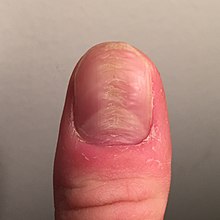32:
119:
Habit-tic deformity is recognizable for its horizontal ridges that create a fir-tree shape. Discoloration along the affected area of the nail is also common. The condition is not to be confused with
123:, a similar but rarer condition which additionally includes a canal-like vertical ridge. The deformity is most commonly seen on the thumbs, but is also less commonly seen on other nails.
131:
Habit-tic deformity is caused by long-term external trauma to the nail matrix as a result of skin-picking around the affected nail. The underlying cause is habitual skin picking as a
111:. The condition is characterized by ridges which run horizontally across the entire nail, most often occurring on the thumbs, as well as marked damage to or absence of cuticles.
155:
Cessation of trauma to the nail is an effective treatment for habit-tic deformity. Several methods have been shown to be effective, including the application of
147:. However, there is no preceding anxiety and subsequent relief felt by an individual after picking, differentiating it from compulsions associated with OCD.
144:
132:
56:
Horizontal ridges on the nail, most commonly thumbnails; Damage to/absence of cuticle; Broken skin around affected nail; stress
387:
135:
which often worsens during times of stress, boredom, or inactivity. In the past, habit-tic deformity has been linked to
159:
to form an artificial cuticle and promote nail root growth, as well as wearing bandages or tape to prevent picking.
397:
96:
69:
31:
120:
74:
327:"Body-Focused Repetitive Behaviors (BFRBs) | Anxiety and Depression Association of America, ADAA"
51:
392:
363:
308:
290:
251:
233:
92:
39:
298:
282:
241:
225:
78:
303:
270:
246:
213:
108:
381:
326:
156:
88:
140:
181:
351:
286:
44:
182:"Habit Tic Nail Deformity - American Osteopathic College of Dermatology (AOCD)"
271:"Median Canaliform Dystrophy of Heller occurring on thumb and great toe nails"
367:
294:
237:
312:
255:
229:
136:
16:
Condition of the nail caused by external trauma to the nail matrix
107:
is a condition of the nail caused by external trauma to the
84:
68:
60:
50:
38:
24:
212:Perrin, Andrew J.; Lam, Joseph M. (2014-03-18).
8:
30:
21:
302:
245:
168:
64:External trauma to proximal nail fold.
7:
207:
205:
203:
201:
176:
174:
172:
275:Medical Journal, Armed Forces India
350:Meffert, Jeffrey J. (1998-11-01).
14:
133:body-focused repetitive behavior
1:
145:obsessive-compulsive disorder
287:10.1016/j.mjafi.2015.06.020
414:
356:American Family Physician
29:
269:Pathania, Vikas (2016).
97:habit reversal training
157:cyanoacrylate adhesive
89:Cyanoacrylate adhesive
70:Differential diagnosis
214:"Habit-tic deformity"
121:median nail dystrophy
75:Median nail dystrophy
388:Medical terminology
230:10.1503/cmaj.121942
105:Habit-tic deformity
25:Habit-tic deformity
115:Signs and symptoms
102:
101:
19:Medical condition
405:
372:
371:
347:
341:
340:
338:
337:
323:
317:
316:
306:
266:
260:
259:
249:
209:
196:
195:
193:
192:
178:
93:behavior therapy
91:(instant glue),
34:
22:
413:
412:
408:
407:
406:
404:
403:
402:
398:Nails (anatomy)
378:
377:
376:
375:
349:
348:
344:
335:
333:
325:
324:
320:
268:
267:
263:
211:
210:
199:
190:
188:
180:
179:
170:
165:
153:
129:
117:
20:
17:
12:
11:
5:
411:
409:
401:
400:
395:
390:
380:
379:
374:
373:
342:
318:
281:(2): 178–179.
261:
197:
167:
166:
164:
161:
152:
149:
128:
125:
116:
113:
100:
99:
86:
82:
81:
72:
66:
65:
62:
58:
57:
54:
48:
47:
42:
36:
35:
27:
26:
18:
15:
13:
10:
9:
6:
4:
3:
2:
410:
399:
396:
394:
391:
389:
386:
385:
383:
369:
365:
361:
357:
353:
346:
343:
332:
328:
322:
319:
314:
310:
305:
300:
296:
292:
288:
284:
280:
276:
272:
265:
262:
257:
253:
248:
243:
239:
235:
231:
227:
223:
219:
215:
208:
206:
204:
202:
198:
187:
183:
177:
175:
173:
169:
162:
160:
158:
150:
148:
146:
142:
138:
134:
126:
124:
122:
114:
112:
110:
106:
98:
94:
90:
87:
83:
80:
76:
73:
71:
67:
63:
59:
55:
53:
49:
46:
43:
41:
37:
33:
28:
23:
359:
355:
352:"All Thumbs"
345:
334:. Retrieved
330:
321:
278:
274:
264:
221:
217:
189:. Retrieved
186:www.aocd.org
185:
154:
141:tic disorder
130:
118:
104:
103:
79:Beau's lines
362:(7): 1647.
109:nail matrix
45:Dermatology
382:Categories
336:2020-02-17
224:(5): 371.
191:2020-02-17
163:References
368:0002-838X
295:0377-1237
238:0820-3946
151:Treatment
85:Treatment
40:Specialty
393:Symptoms
331:adaa.org
313:27257330
256:24043663
52:Symptoms
304:4878880
247:3956568
137:anxiety
366:
311:
301:
293:
254:
244:
236:
143:, and
127:Causes
61:Causes
364:ISSN
309:PMID
291:ISSN
252:PMID
234:ISSN
218:CMAJ
299:PMC
283:doi
242:PMC
226:doi
222:186
384::
360:58
358:.
354:.
329:.
307:.
297:.
289:.
279:72
277:.
273:.
250:.
240:.
232:.
220:.
216:.
200:^
184:.
171:^
139:,
95:,
77:,
370:.
339:.
315:.
285::
258:.
228::
194:.
Text is available under the Creative Commons Attribution-ShareAlike License. Additional terms may apply.
